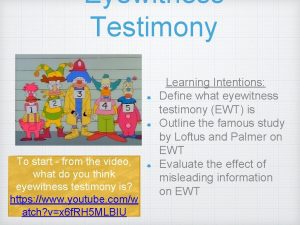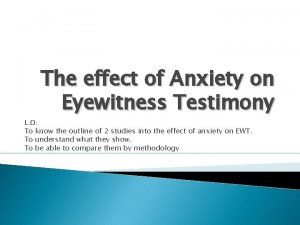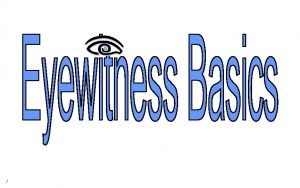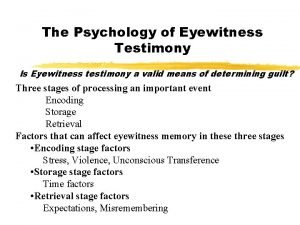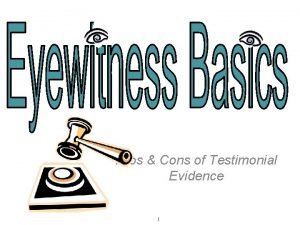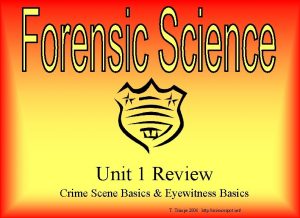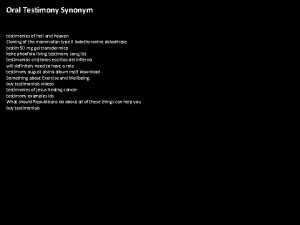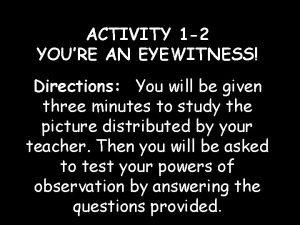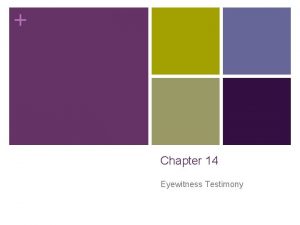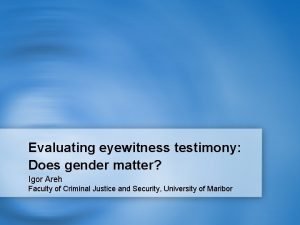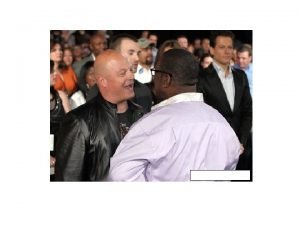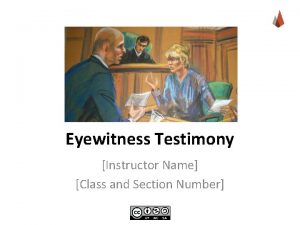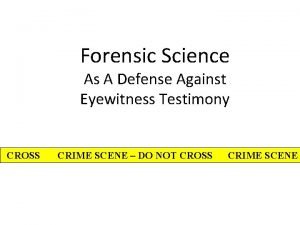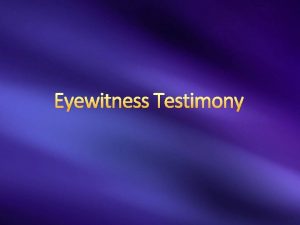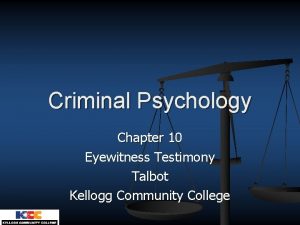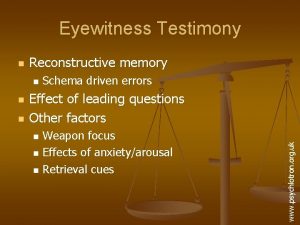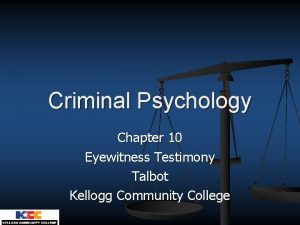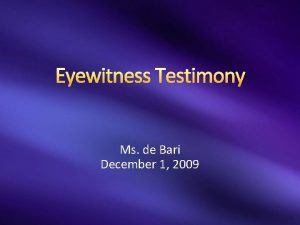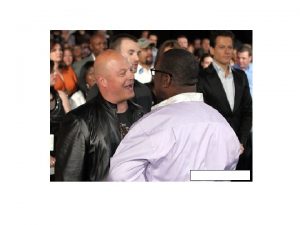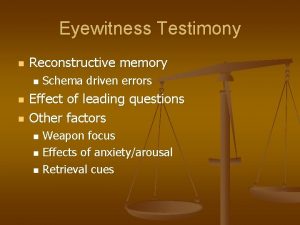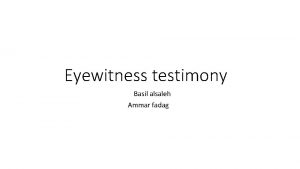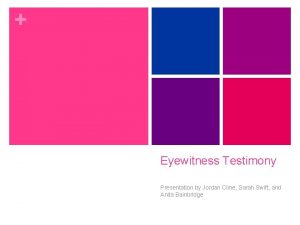Eyewitness Testimony To start from the video what






















- Slides: 22

Eyewitness Testimony To start - from the video, what do you think eyewitness testimony is? https: //www. youtube. com/w atch? v=x 6 f. RH 5 MLBIU Learning Intentions: Define what eyewitness testimony (EWT) is Outline the famous study by Loftus and Palmer on EWT Evaluate the effect of misleading information on EWT

Eyewitness Testimony The men on the left and right were picked out of police lineups by victims of rapes and robberies committed by the man in the middle

Eyewitness Testimony For the innocent men, false recall could be tragic, he may end up in prison. In pairs, make a list of things that you think can effect the accuracy of recall of an event (EWT)

Misleading Information What do you think misleading information is? What does research into EWT tell us about misleading information?

Misleading Information Do the experiment in groups of 4. Consider the following:

Misleading Information What does this experiment tell us about misleading information?

Leading Questions A leading question is a question that contains info previously unknown to the witness. Leading questions pose many problems in criminal proceedings because many police and lawyers ask them! (it may be subtle!) This previously unknown info has the potential to change the witness’ understanding of the event and later when asked about the incident, that particular info has been implanted in their recollection of what happened.

Reconstruction of Automobile Loftus and Palmer Destruction (1974) conducted research in which people were deliberately given misleading information about what they had seen. They showed that it was possible to alter people’s memories

Loftus and Palmer (1974) As you move around the room, use the information sheets to fill in your yellow study sheet for both Experiment 1 and Experiment 2 by Loftus and Palmer (1974) Procedure Findings

Evaluation and Implications for real life Loftus and Palmer say that EWT’s are little more than guesses. Their findings were highly influential in the writing of The Devlin Report, which concluded that, unless circumstances were highly unusual, EWT alone should not result in a conviction in an English court!

Loftus (2001) PPs shown fake advert of Bugs Bunny at Disneyland Asked if they remembered meeting ‘Bugs’ on childhood visits to Disneyland 35% reported doing so Impossible, because Bugs Bunny is a Warner Bros character Supports Loftus car crash research which found that it’s possible to alter memory

In your groups discuss the following and make notes: How realistic were studies on misleading information? the tasks the participants did, and real life situations where you nee Who were the participants? (Could the results be generalised to other people? ) How useful was the research? (Do the results of the study have any real world applications? ) Any other issues? (Think about the type of tasks, the content of the video etc. )

External Validity – This was low because it was a laboratory study, and the participants knew they were taking part in an experiment. In real-life situations there would be an element of surprise, so you might not be paying attention. There would be an increase in emotion – such as fear, shock, etc. There may be victims. You might not be asked questions until some time later. You may have the opportunity to discuss what you

EWT main There has been a great deal of research Conclusion into this area, mainly by Loftus, despite this we can draw no absolute conclusions because some of the evidence is conflicting However, it is clear that the memory is fragile and that peripheral information can be fairly easily distorted especially if: witnesses are allowed to talk to other people, the police ask leading questions or there is a long time delay between the event and getting the first witness

Reflection and Homework Are you a good eyewitness now? https: //www. youtube. com/watch? v= 8 -hap. S 2 SPz 4 What is the difference between the traditional model of recall and Loftus’ model of recall? Complete your Loftus study sheet Finish Learning activities 7. 4 and 7. 6

A 01’s: Introduction: Loftus and Palmer (1974) laboratory experiment Independent measures design IV = Verb used DV = The estimate of speed or whether the P saw glass

A 01’s Method – Experiment 1 45 student participants were shown short video clips They were split into 5 groups, with 9 participants in each one All of the participants were asked: ‘About how fast were the cars going when they ____ each other’

Method – Experiment 1 Each group was given a different verb to fill in the blank. These verbs were ‘smashed, collided, bumped, hit or contacted’. Therefore the independent variable was the verb used. The dependent variable was the estimate of speed given by the participants

Findings – Experiment 1 VERB MEAN ESTIMATE OF SPEED (mph) Smashed Collided Bumped Hit Contacted 40. 8 39. 3 38. 1 34. 0 31. 8 What do these results show? • How the question was phrased influenced the participants’ speed estimates • When the verb ‘smashed’ was used, participants estimated that the cars were travelling much faster than when the verb ‘contacted’ was used.

Method – Experiment 2 150 student participants shown a short film that showed a multi-vehicle car accident and then they were asked questions about it. participants were split into 3 groups. One group was asked: ‘How fast were the cars going when they hit each other? ’

Method – Experiment 2 The second group was asked: ‘How fast were the cars going when they smashed into each other? ’

Results – Experiment 2 Did you see any broken glass? Response Smashed Yes 32% Hit 14% The results show that the questions following an event can influence our memories. Control (Not asked about speed) 12%
 Eyewitness testimony video experiments
Eyewitness testimony video experiments Igor areh
Igor areh Pros and cons of eyewitness testimony
Pros and cons of eyewitness testimony Eyewitness basics
Eyewitness basics Pros and cons of eyewitness testimony
Pros and cons of eyewitness testimony Accuracy of eyewitness testimony
Accuracy of eyewitness testimony But we gotta start somewhere
But we gotta start somewhere Jump start triage
Jump start triage Eyewitness basics worksheet answers
Eyewitness basics worksheet answers Eyewitness synonym
Eyewitness synonym The story of an eyewitness by jack london
The story of an eyewitness by jack london Eyewitness basics worksheet answers
Eyewitness basics worksheet answers Eyewitness to history flagellants
Eyewitness to history flagellants Video yandex ru
Video yandex ru Tw.search.yahoo.com
Tw.search.yahoo.com Video.search.yahoo.com search video
Video.search.yahoo.com search video The frame size of a video refers to the video’s
The frame size of a video refers to the video’s Công thức tính thế năng
Công thức tính thế năng Phép trừ bù
Phép trừ bù Tỉ lệ cơ thể trẻ em
Tỉ lệ cơ thể trẻ em Thế nào là mạng điện lắp đặt kiểu nổi
Thế nào là mạng điện lắp đặt kiểu nổi Lời thề hippocrates
Lời thề hippocrates Vẽ hình chiếu đứng bằng cạnh của vật thể
Vẽ hình chiếu đứng bằng cạnh của vật thể
